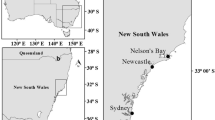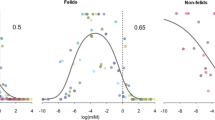Abstract
The diets of 5 species of embiotocids (Rhacochilus vacca, Embiotoca jacksoni, Hypsurus caryi ryi, Phanerodon furcatus and Micrometrus minimus) from King Harbor, Redondo Beach, California, USA, are examined by means of a dietary survey, field feeding observations and bomb calorimetry of prey items. Each species is shown to have statistically different diets from all others, with the exception of H. caryi which apparently is a dietary intermediate between E. jacksoni and P. furcatus. Dietary overlap between E. jacksoni and H. caryi appears to have resulted in some competitive exclusion along other niche parameters. Estimated caloric intakes suggest that R. vacca has the highest caloric yield per bite and the lowest feeding rate of the species studied. Possible energetic advantages are found for diet specialization in R. vacca.
Similar content being viewed by others
Literature Cited
Bray, R.N. and A.W. Ebeling: Food, activity, and habitat of three “picker-type” microcarnivorous fishes in the kelp forests off Santa Barbara, California. Fish. Bull. U.S. 73, 815–829 (1975)
Brett, J.R.: The relation of size to rate of oxygen consumption and sustained swimming speed of sockeye salmon (Oncorhynchus nerka). J. Fish. Res. Bd Can. 22 1491–1501 (1965)
Burns, C.W. and F.H. Rigler: Comparison of filtering rates of Daphnia rosea in lake waters and in suspensions of yeast. Limnol. Oceanogr. 12, 492–502 (1967)
Charnov, E.L., G.H. Orians and K. Hyatt: Ecological implications of resource depression. Am. Nat. 110, 247–259 (1976)
Cook, R.M. and B.J. Cockrell: Predator ingestion rate and its bearing on feeding time and the theory of optimal diets. J. Animal. Ecol. 47, 529–547 (1978)
Cushing, D.H.: A comparison of production in temperate seas and in upwelling areas. Trans. R. Soc. S. Africa 40, 17–33 (1972)
Davis, G.E. and C.E. Warren: Estimation of food consumption rates. In: Methods for assessment of fish production in fresh water, pp 204–225. Ed. by W.E. Ricker. Oxford and Edinburgh: Blackwell Scientific Publications 1968. (Int. biol. Progm. Handbk No. 3)
Estabrook, F. and A.E. Dunham: Optimal diet as a function of absolute abundance, relative abundance, and relative value of available prey. Am. Nat. 110, 401–413 (1976)
Ellison, J.P.: Comparative diet analysis of the mountain white-fish, Prosopium williamsoni (Girard), and the eastern brook trout, Salvalinus fontinalis (Mitchill), in the Little Walker River, Mono County, California, 52 pp. M.A. thesis, California State University, Long Beach, California, USA 1977
Halver, J.E.: Fish nutrition, 712 pp. New York: Academic Press 1972
Hubbs, C.L.: The ecology and life history of Amphigonopterus aurora and other viviparous perches of California. Biol. Bull. mar. biol. Lab., Woods Hole 40, 181–209 (1921)
Lindsay, D.A.: The effect of ration size on gastric evacuation and bioenergetics of the Pacific staghorn sculpin Leptocottus armatus Girard, 55 pp. M.A. thesis, California State University, Long Beach, California, USA 1975
Nie, N.H., C.H. Hull, J.G. Jenkins, K. Steinbrenner and D.H. Bent: Statistical programs for the social sciences, 675 pp. New York: McGraw-Hill Book Co. 1970
Pianka, E.R.: The structure of lizard communities. A. Rev. Ecol. Syst. 4, 53–74 (1973)
—: Evolutionary ecology, 356 pp. New York: Harper & Row 1974
Pulliam, H.: Diet optimization with nutrient constraints. Am. Nat. 109, 765–768 (1975)
Sokal, R.R. and F.J. Rohlf: Biometry, The principles and practice of statistics in biological research, 776 pp. San Francisco: W.H. Freeman & Co. 1969
Terry, C.B.: The role of depth, temperature, diet and feeding periodicity in resource partitioning among the surfperch (family Embiotocidae) in King Harbor, California, 145 pp. M.A. thesis, Occidental College, Los Angeles, USA 1975
— and J.S. Stephens, Jr.: A study of the orientation of selected embiotocid fishes to depth and shifting seasonal vertical temperature gradients. Bull.Sth. Calif.Acad.Sci. 75, 170–183 (1976)
Werner, E.: Species packing and niche complementarity in three sunfishes. Am. Nat.111, 553–578 (1977)
Winberg, G.G. (Ed.): Methods for the estimates of production of aquatic animals, 175 pp. London & New York: Academic Press 1971
Author information
Authors and Affiliations
Additional information
Communicated by N.D. Holland, La Jolla
Rights and permissions
About this article
Cite this article
Ellison, J.P., Terry, C. & Stephens, J.S. Food resource utilization among five species of embiotocids at King Harbor, California, with preliminary estimates of caloric intake. Marine Biology 52, 161–169 (1979). https://doi.org/10.1007/BF00390424
Accepted:
Issue Date:
DOI: https://doi.org/10.1007/BF00390424




